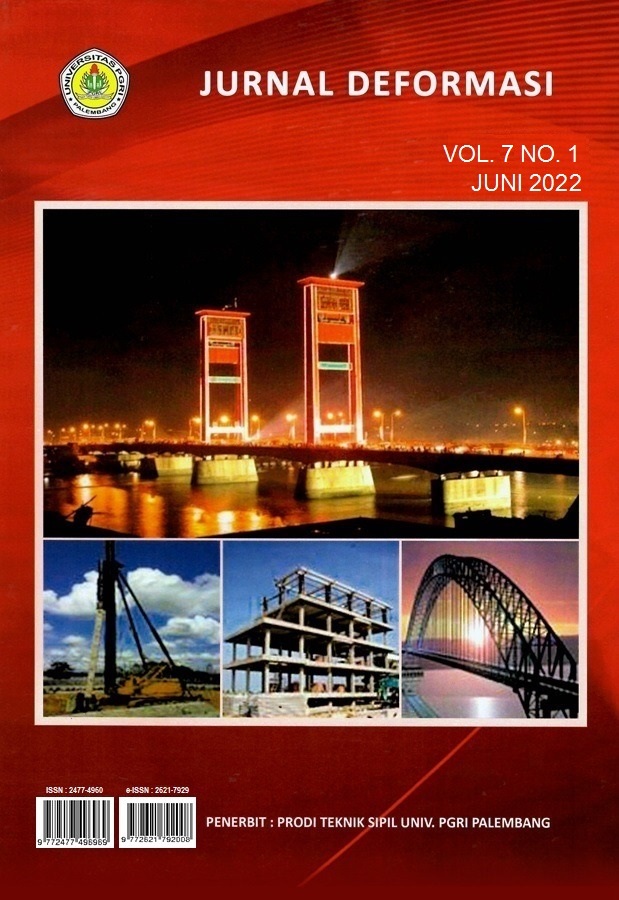Variasi Molaritas Naoh Dan Alkali Aktivator Beton Geopolimer
DOI:
https://doi.org/10.31851/deformasi.v7i1.7983Keywords:
Molaritas, NaOH, Na2SiO3, fly ash, alkali activator, kuat tekan.Abstract
Cement as a building material for concrete produces CO2 which can damage the earth's atmosphere. Therefore, environmentally friendly geopolymer concrete is the choice. The main ingredients for making this concrete are pozzolanic materials which are rich in Silica (SiO3) and Alumina (Al2O3) as a substitute for cement and alkali activator in the form of Sodium Hydroxide (NaOH) and (Na2SiO3) as binders.
This study aims to determine the variation of the mixture for the highest compressive strength. The ratio of fly ash type F and alkali activator is 74%:26%. The molarity of NaOH used was 10M, 12M, 14M, the ratio of Na2SiO3 and NaOH was 2.5:1; 3.0:1; 3.5:1. The test object is cylindrical size 15cm x 30cm and the compressive strength test is 28 days old.
The test results with the ratio of NaOH and Na2SiO3 2.5:1 at 10M, 12M, 14M NaOH are 25.81 Mpa, 27.00 MPa, 28.98 MPa. While the compressive characteristics are 24.32 Mpa, 24.67 Mpa, 26.58 Mpa. The test results show that the ratio of molarity and alkali activator greatly affects the compressive strength and workability of geopolymer concrete. High molarity will produce high compressive strength. Meanwhile, the higher the alkali activator ratio, the lower the compressive strength produced.
Â
References
ACI 318-89 Building Code Requirements for Reinforce Concreate.
ASTM. (2003). ASTM C618-03, Standard Specification for Fly Ash and Row or Calcinated Natural Pozzolan for Use as a Mineral Admixture in Portland Cement Concreate.
Badan Standardisasi Nasional. (2002). Tata Cara Perhitungan Struktur Beton Untuk Bangunan Gedung. SNI 03-2847-2002. Bandung: Badan Standardisasi Nasional, 251.
Mulyono, T. (2005). Teknologi Beton, Yogyakarta.
Nawy, E. G. (1990). Reinforce concreate a fndamental Approach.
Nugraha, P., & Antoni. (2007). Teknologi Beton.
PBI. (1971). Penjelasan & Pembahasan mengenai Peraturan Beton Indonesia 1971
SNI 03-2834-2000. (2000). SNI 03-2834-2000: Tata cara pembuatan rencana campuran beton normal.
Sudarmo, U. (2013). Kimia. Penerbit Erlangga.
Adi S, D., Rahman N, F., Lie, H. A., & Purwanto. (2018). Studi Experimental Pengaruh Perbedaan Molaritas Aktivator Pada Perilaku Beton Geopolimer Berbahan Dasar Fly Ash.
Al Bari, M. S. (2019). Simulasi Perilaku Beton Geopolimer Serat Baja Terhadap Ledakan.
Bangun, Abdul Jalil, Johannes Tarigan, dan A. P. (2021). Pengaruh Variasi Molar Pada Kuat Tekan Mortar Geopolimer Berbahan Dasar Fly Ash PLTU Pangkalan Susu.
Budh, C. D., & Warhade, N. R. (2014). Effect of molarity on compressive strength of geopolymer mortar.
Ekaputri, J. J., & Triwulan, T. (2013). Sodium sebagai Aktivator Fly Ash, Trass dan Lumpur Sidoarjo dalam Beton Geopolimer.
Hadjito, D, Wallah S.E dan Rangan, B. . (2004). Factor Infuencing The Compressive Strength of Fly Ash Based Geopolimer Concreate, Civil Engineering Dimension. 6. Issue: 2, hal. 88.
K, T., Louise Frank G, & Collins. (2013). Carbon Dioxide Equivalent (CO2-e) emmissions: A comarison Between Geopolimer and OPC cement concrete.
Karyawan Salain, I. M. A., Wiryasa, N. M. A., & Adi Pamungkas, I. N. M. M. (2021). Kuat Tekan Beton Geopolimer Menggunakan Abu Terbang.
Kasyanto, H. (2012). Tinjauan Kuat Tekan Geopolimer Berbahan Dasar Fly Ash dengan Aktivator Sodium Hidroksida dan Sodium Silikat.
Mustofa. (2016). Studi Pengaruh Rasio Si / Al Terhadap Sifat Fisik-Mekanik Semen Geopolimer Berbasis Terak Feronikel.
Qomaruddin, M., Munawaroh, T. H., & Sudarno, S. (2018). Studi Komparasi Kuat Tekan Beton Geopolimer dengan Beton Konvensional.
Rachmalia, Q. (2018). Pengaruh Urutan Penambahan Alkali Aktivator Pada Beton Geopolimer Berbahan Dasar Fly Ash Tipe C.
Ridwan, M. (2018). Karakteristik Beton Geopolimer Menggunakan Limbah Fly Ash Pltu Tanjung Jati B Jepara ( Characteristic of Geopolymer Concrete Using Fly Ash Waste From Pltu Tanjung Jati B Jepara ) Fakultas Teknik Sipil Dan Perencanaan Limbah Fly Ash Pltu Tanjung Jati B.
Risdanareni, Puput ; Triwula ; Ekaputri, Januarti Jaya. (2014).Pengaruh Molaritas Aktifator Alkalin Terhadap Kuat Mekanik Beton Geopolimer dengan Trass Sebagai Pengisi.
Septia G, P. (2011). Literature Study Comparative Effect of Concentration of Naoh and Ratio of Naoh : Na2Sio3 , Ratio of Water / Precursor , Curing Temperature , and Type of Precursor To Compression Strength .
Skavara, F, Kopecky, L, Nemecek, J. dan Bittnar, Z. (2006). Microstructure of Geopolymer Materials Based on Fly ash. Ceramcs-Silikaty.
Swardika, D. P., Herlina, L., Laely, A., & Kardin, F. (2019). Pengaruh Rasio Larutan Alkali Aktifator Berbasis Fly Ash Ex Pltu Suralaya Banten The Effect Of Alkaline Activator On Compressive Strength Geopolymer Concrete Fly Ash Based Ex Electric Steam Power Plant Suralaya Banten.
Syafputra, B., & Kurniawati, E. K. (2020). Pengaruh Variasi Molaritas Pada Kuat Tekan Beton Geopolymer Fly Ash Dengan Agregat Halus Pasir Kuarsa.
Yasin, A. K. (2017). Rekayasa Beton Geopolimer Berbasis Fly Ash.
Downloads
Published
How to Cite
Issue
Section
License

Authors retain copyright and grant the journal right of first publication with the work simultaneously licensed under a Creative Commons Attribution-NonCommercial-ShareAlike 4.0 International License that allows others to share the work with an acknowledgement of the work's authorship and initial publication in this journal.



.png)
.png)


